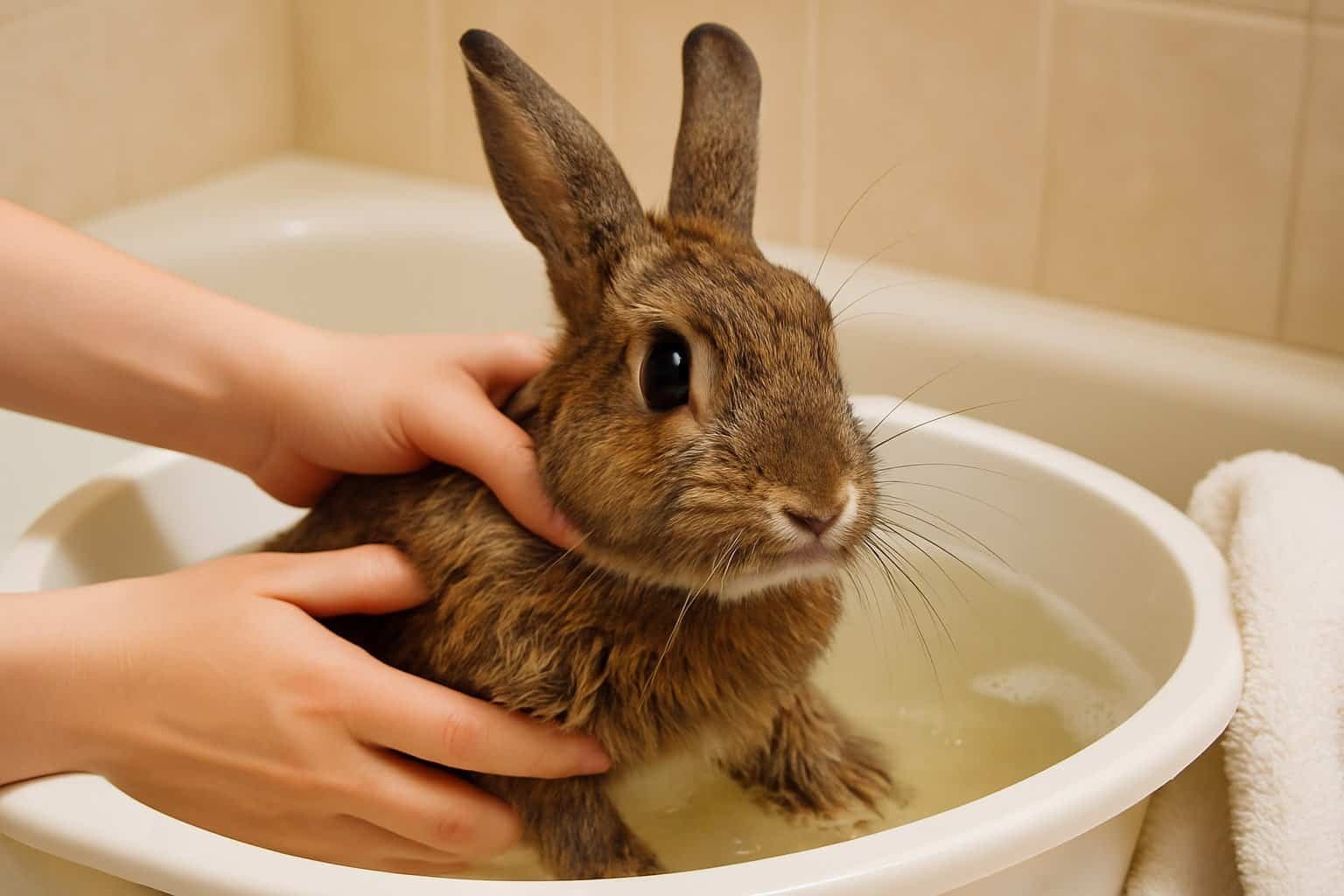Keeping your rabbit clean is essential, but bathing a rabbit without stress can be a delicate process. Unlike other pets, rabbits are naturally fastidious groomers and rarely need a full bath. In fact, improper bathing can cause severe stress or even life-threatening health issues for rabbits.
This guide will walk you through everything you need to know to bathe your rabbit safely, calmly, and correctly.
In This Article
Understanding Rabbit Hygiene Needs
Rabbits are self-grooming animals. They regularly clean their fur by licking themselves, similar to cats. In most cases, your rabbit can manage its hygiene without your intervention.
However, there are rare occasions when bathing may become necessary, such as:
- Soiling: If your rabbit is unable to clean itself due to obesity, arthritis, or illness.
- Urine Scald: When urine burns and irritates the rabbit’s skin.
- Sticky Substances: If something hazardous or sticky has gotten on the fur.
- Veterinarian’s Recommendation: Sometimes a vet may advise a bath for medical reasons.
👉 It’s important to note that regular baths are not part of a healthy rabbit care routine. Inappropriate bathing can lead to shock, hypothermia, and even heart failure in rabbits.
Quick Fact:
According to the House Rabbit Society, rabbits rarely need baths and spot cleaning is almost always preferred.
Why Bathing Can Be Stressful for Rabbits
For rabbits, water is not a natural environment. Unlike dogs or some small mammals, rabbits instinctively fear large amounts of water. Here’s why bathing is highly stressful for rabbits:
- Risk of Shock: Sudden exposure to water can terrify a rabbit, causing panic or stress-induced shock.
- Hypothermia Danger: Their thick fur traps water, making it difficult to dry them quickly and efficiently. Even brief dampness can lead to a dangerous drop in body temperature.
- Physical Injury: Rabbits can injure themselves trying to escape a bath, especially if they panic and kick out.
- Respiratory Issues: Water can enter a rabbit’s nose or ears, potentially leading to infections or pneumonia.
“Bathing rabbits is not recommended unless absolutely necessary. The stress and potential health risks outweigh any perceived cleanliness benefits.”
— House Rabbit Society
Signs of Rabbit Stress During Bathing:
- Rapid breathing
- Wide eyes
- Freezing in place or frantic struggling
- Teeth grinding (a sign of pain or distress)
Understanding these risks is key to learning how to bathe your rabbit in the safest, most stress-free way possible.
When You Should Bathe a Rabbit (And When You Shouldn’t)
Bathing should always be a last resort for rabbits. In most situations, a dry bath or spot cleaning is safer and just as effective.
| Situation | Recommended Action |
| Sticky or toxic substances on fur | Gentle bath if necessary |
| Matted fur | Dry bath or grooming |
| Obesity or mobility issues | Spot cleaning preferred |
| Urine scald or diarrhea | Vet may recommend bathing |
| Routine hygiene | No bath needed |
When You Should Bathe:
- Severe soiling that can’t be removed with dry methods.
- Vet-directed medicated baths for skin conditions.
- Accidents involving harmful substances.
When You Should Avoid Bathing:
- Minor dirt or dust can be handled with a soft brush.
- Regular grooming should be done with a comb or fur brush.
- Dry skin, minor stains, and shedding don’t require water.
👉 In most cases, spot cleaning and preventive grooming are far safer and more effective for rabbit hygiene.
Preparing the Bathing Area
Before you begin, creating a safe, calm, and secure bathing space is crucial for minimizing your rabbit’s stress.
Key Preparation Tips:
- Non-Slip Surface: Place a soft towel or rubber mat at the bottom of the sink or basin to prevent slipping.
- Shallow Water: Fill with only 1-2 inches of lukewarm water. Rabbits should never be submerged.
- Comfortable Room Temperature: Keep the room warm to prevent your rabbit from getting chilled.
- Have Everything Ready: Prepare towels, rabbit-safe shampoo, and a cup for pouring water within arm’s reach to avoid leaving your rabbit unattended.
“A secure and quiet environment makes a huge difference in keeping rabbits calm during cleaning.”
— Rabbit Care Association
Choosing the Right Bathing Method
Not all rabbit cleaning situations require the same approach. Selecting the correct method can prevent unnecessary stress and health risks.
Bathing Methods for Rabbits:
| Method | When to Use |
| Full Wet Bath | Only for severe soiling or vet advice |
| Spot Cleaning | Minor messes, small dirty patches |
| Dry Bath | Light dirt, excess oil, or surface dust |
Full Wet Bath
- Should only be used if your rabbit is heavily soiled.
- Always keep the water shallow and focused on dirty areas.
Spot Cleaning
- Use a damp cloth or a small spray bottle.
- Target only the affected area to keep most of the rabbit dry.
Dry Bath
- Sprinkle cornstarch-based powder (no talc) and gently brush it out.
- Safe for minor dirt and sensitive rabbits who cannot tolerate water.
👉 For most situations, spot cleaning or dry bathing is the best option to clean a rabbit without stress.
Gathering the Necessary Supplies
Having the right tools on hand before start bathing rabbit can make the process smoother and safer.
Rabbit Bathing Essentials:
- Rabbit-Safe Shampoo: Choose mild, unscented, and chemical-free shampoos specifically for small animals.
- Towels: Prepare two—one for the bathing area and another for drying.
- Non-Slip Mat: Prevents slipping and reduces panic.
- Cup or Small Jug: For controlled rinsing.
- Soft Cloths or Cotton Pads: Ideal for spot cleaning.
- Cornstarch Powder: For dry baths to absorb dirt and oil.
- Treats: To reward and calm your rabbit afterward.
📝 Important: Never use human shampoos, dish soaps, or dog/cat shampoos—they can irritate a rabbit’s delicate skin and disrupt natural oils.
Example of Rabbit-Safe Bathing Products:
| Product Type | Example | Purpose |
| Rabbit-safe shampoo | Kaytee Squeaky Clean Shampoo | Gentle cleaning |
| Dry bath powder | Pure cornstarch (no talc) | Dry cleaning |
| Grooming brush | Soft bristle brush | Regular maintenance |
Proper preparation ensures that the bathing process is quick, safe, and as stress-free as possible.
Step-By-Step Guide: Bathing a Rabbit Safely
If a bath is unavoidable, follow this safe, step-by-step process to minimize your rabbit’s stress.
Bathing Process:
- Prepare the Area: Set up your supplies within easy reach.
- Secure Your Rabbit: Hold gently but firmly to prevent sudden movements.
- Use Lukewarm Water: Pour a small amount into the sink (no deeper than 1-2 inches).
- Wet the Soiled Area: Avoid getting water on the rabbit’s face, ears, and nose.
- Apply Rabbit-Safe Shampoo: Gently massage the dirty fur without scrubbing harshly.
- Rinse Thoroughly: Use a cup to carefully pour lukewarm water over the fur until soap is fully removed.
- Immediate Drying: Wrap your rabbit in a soft towel and gently pat the fur. Do not rub vigorously.
Never use a hairdryer. The noise and heat can frighten rabbits and cause burns or stress.
Drying the Rabbit Properly
Thorough drying is critical to prevent hypothermia and fungal infections.
Safe Drying Tips:
- Towel Dry Only: Pat dry gently with a soft, absorbent towel.
- Warm Environment: Keep your rabbit in a warm, draft-free room until completely dry.
- Replace Towels if Needed: If the first towel becomes soaked, switch to a dry one.
- Do Not Use Heat Sources: Avoid hair dryers, heating pads, or direct sunlight.
Keeping your rabbit warm and comfortable during drying is just as important as the bath itself.
Calming Techniques During and After Bathing
A rabbit that feels secure will experience less stress throughout the cleaning process.
During the Bath:
- Speak in a soft, soothing voice.
- Gently stroke your rabbit’s head or ears.
- Move slowly and calmly to avoid triggering panic.
After the Bath:
- Wrap your rabbit snugly in a dry towel and hold them close.
- Offer a favorite treat or healthy snack.
- Allow your rabbit to rest in a quiet space.
- Brush them gently to comfort and distract.
“Building trust is key. If your rabbit trusts you, they will feel safer even during stressful moments.”
— Veterinary Rabbit Care Specialist, Dr. Emily Chen
Signs of Rabbit Stress to Watch For
Recognizing when your rabbit is overwhelmed can prevent serious health issues.
Common Signs of Stress:
- Rapid breathing or panting
- Trembling or freezing in place
- Vocalizing or teeth grinding
- Attempting to escape frantically
- Lethargy or hiding after bathing
- Refusing to eat
👉 If you notice these signs, immediately stop the bath and comfort your rabbit.
🩺 Consult a vet if your rabbit shows ongoing signs of distress, becomes unresponsive, or has trouble breathing after bathing.
Alternatives to Bathing: Dry Bath and Spot Cleaning
Whenever possible, use dry methods to clean your rabbit. They are safer and much less stressful.
Dry Bath Method:
- Sprinkle cornstarch powder over the soiled fur.
- Gently massage it into the coat.
- Carefully brush out the dirt and powder.
- Wipe with a soft, dry cloth.
Spot Cleaning:
- Use a damp cloth or baby wipe (unscented, alcohol-free).
- Clean only the affected area.
- Pat dry immediately.
These methods avoid the risks of wet baths and are often enough to keep your rabbit clean and healthy.
Final Tips and Precautions
To keep your rabbit stress-free and safe during hygiene routines, always remember:
- Never bathe your rabbit unless absolutely necessary.
- Regular grooming and proper diet prevent most hygiene issues.
- Use the right products and avoid anything harsh or scented.
- Monitor your rabbit closely for signs of stress during and after cleaning.
| Safe Practices | Dangerous Practices |
| Use rabbit-safe shampoo | Use human or pet shampoos |
| Keep the rabbit warm | Leave rabbit wet or in a draft |
| Bathe only when absolutely needed | Bathe regularly or without cause |
| Choose spot cleaning when possible | Submerge the rabbit completely |
If you’re unsure, it’s always best to consult a rabbit-savvy veterinarian before attempting a bath.

